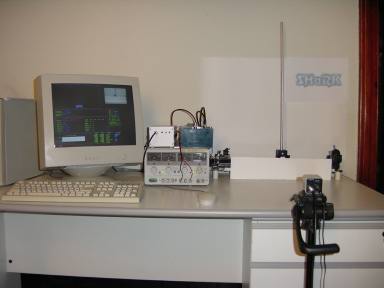Real-Time Inverted Pendulum
Home page
Real-Time Inverted Pendulum
Home page
[ Home | Papers
| Presentation slides | Photo+Movie
gallery | Links | Authors
]

Presentation of the experiment
To see a presentation with the details of the apparatus and some experimental
results, click here
Pendulum stabilization
Download a movie
(.mpg - 208 KB) of the working apparatus!
This page and related links present explanations,
descriptions, photos, movies, references, etc. on the
Inverted Pendulum Experiment implemented
at RetisLab in Pisa.

An inverted pendulum is a physical device consisting
in a cylinrical bar (usually of alluminum) free to oscillate around
a fixed pivot. The pivot is mounted on a carriage, which in its turn can
move on a horizontal direction.
The carriage is driven by a motor, which can exert on it a variable
force.
The bar would naturally tend to fall down from the top vertical position,
which is a position of unsteady equilibrium.
The goal of the experiment is to stabilize the pendulum (bar) on the
top vertical position.
This is possible by exerting on the carriage through the motor
a force which tends to contrast the 'free' pendulum dynamics.
The correct force has to be calculated measuring the instant values
of the horizontal position and the pendulum angle (obtained e.g. through
two potentiometers).
The system pendulum+cart+motor can be modeled as a linear system if
all the parameters are known (masses, lengths, etc.), in order to find
a controller to stabilize it. If not all the parameters are known, one
can however try to 'reconstruct' the system parameters using measured data
on the dynamics of the pendulum.
The Real-Time Inverted Pendulum is used as a benchmark, to test
the validity and the performance of the software underlying the state-space
controller alogorithm, i.e. the used operating system.
Actually the algorithm is implement form the numerical point of view
as a set of mutually co-operating tasks, which are periodically activated
by the kernel, and which perform different calculations.
The way how these tasks are activated (e.g. the activation order) is
calleding scheduling of the tasks.
It is obvious that a correct scheduling of each task is crucial for
a good performance of the controller, and hence for an effective pendulum
stabilization.
Thus the inverted pendulum is very useful in determing whether a particular
schedulig choice is better than another one, in which cases, to which extent,
and so on.
To see a more detailed presentation of the system, and some experimental
results, click here.